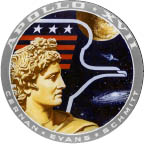
In September 1970, NASA canceled the last two remaining Apollo missions of the three originally planned beyond Apollo 17, making 17 the final lunar landing of the program. The crew was composed of CDR Gene Cernan—making his third space flight and second trip to the moon—and two rookies: CMP Ron Evans and LMP Harrison “Jack” Schmitt, a member of NASA’s 1965 group of scientist-astronauts. A geologist, Schmitt likely would have flown on Apollo 18; its cancellation prompted NASA to add him to this crew, bumping former test pilot Joe Engle. Cernan reluctantly accepted the substitution.
The alignment of Earth and the moon for a December 1972 launch target meant that Apollo 17 would lift off from Florida at night. NASA issued a fact sheet with advice on how best to photograph the launch. With just thirty seconds to go on the evening of December 6, launch was delayed by two hours and forty minutes because of a glitch in the automatic countdown sequencer. It was the only equipment delay for any manned Apollo launch. At 12:33 a.m. (EST) on December 7, the Saturn V roared to life, briefly but dramatically bathing KSC in an eerie yellow light as the booster climbed into the night sky. An estimated 750,000 spectators were on hand.
On December 10, the crew reached lunar orbit. The next day, as Evans remained behind in CM America , Cernan and Schmitt landed LM Challenger in a valley in the Montes Taurus (mountain range), south of the Littrow Crater in the Sea of Serenity. As an ancient lunar highland, the site was chosen because of its potential to offer clues about the moon’s formation.
For the next seventy-five hours, Cernan and Schmitt conducted the longest—and, in many ways, most productive—lunar exploration of the Apollo program. Late on December 11, they set up Apollo’s third LRV and conducted the first of three seven-hour EVAs. They also deployed the ALSEP, conducted other surface experiments, and collected samples.
Just before this first outing, Cernan accidentally pulled off the rover’s right-rear fender extension with a hammer. He tried to tape it back on, but the duct tape eventually failed because of lunar dust. Before their second EVA the next day, Cernan attached a makeshift fender section, made by taping together four lunar maps. He successfully clamped it to the rover. Schmitt sampled an area of unusual orange soil during the outing; the soil was later believed to have come from an ancient volcanic eruption. They also drove the rover more than 4.5 miles away from the LM, the farthest of any lunar EVA.
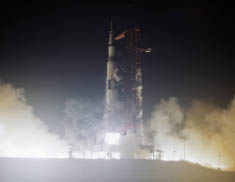
Launch: 12:33 a.m. (EST), December 7, 1972
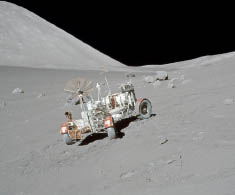
Lunar landing: 2:55 p.m. (EST), December 11. Ascent: 5:55 p.m. (EST), December 14
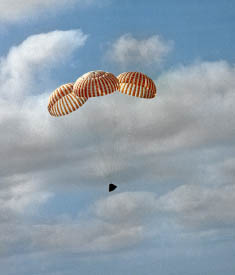
Splashdown: 2:25 p.m. (EST), December 19
The public, however, was not tuning in. The three television networks had cut back coverage of the Apollo 16 moonwalks, airing less than a third of that flight’s time spent in EVA. NASA approached the Public Broadcasting Service about carrying all of Apollo 17’s lunar surface activities, but PBS declined, citing the transmission and production costs involved. CBS and ABC aired about six hours each, while NBC carried just more than ten.
While Cernan and Schmitt were exploring the lunar surface, Evans conducted various scientific tests aboard America , using three new SIM experiments: an infrared radiometer, a UV spectrometer, and a lunar sounder.
During their final expedition on the lunar surface, on December 13, Cernan and Schmitt collected samples of basalts, rocks, and soil; they also unveiled a plaque on the landing gear of Challenger , commemorating all of the Apollo landings. They collected a total of 243 pounds of lunar samples during the mission.
Cernan was the last man on the moon. He entered Challenger shortly after midnight (EST) on December 14, after carefully positioning the rover so that its TV camera could transmit the liftoff of Challenger ’s ascent stage to Earth, with Houston controlling it. The camera successfully tilted up to follow the launch for the first time.
After docking with America, Challenger ’s ascent stage was sent back to the lunar surface. Its impact was recorded by the four Apollo 17 geophones and by the ALSEPs at the Apollo 12, 14, 15, and 16 landing sites.
Apollo 17 then spent a full day in lunar orbit for some final experiments, before heading back toward Earth. On December 17, Evans left America during a one-hour deep space EVA to recover several film cassettes from the SM; the SM, like that of the previous two missions, carried a SIM.
Apollo 17 splashed down in the Pacific Ocean at 2:25 p.m. (EST), 348 miles west of the islands of Samoa and 4 miles from the recovery ship, USS Ticonderoga . A recovery helicopter retrieved Cernan, Evans, and Schmitt, who were safely aboard the aircraft carrier fifty-two minutes after landing.
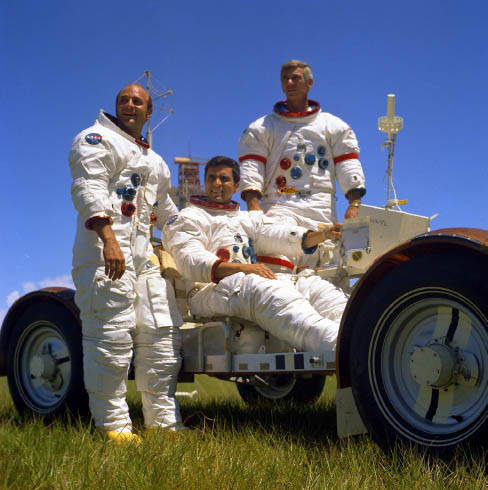
Ron Evans, Harrison “Jack” Schmitt, and Gene Cernan with an LRV trainer near Pad 39A, during a photo session on August 28, 1972. The top of the Saturn V’s LUT can be seen between Evans and Schmitt. (photo by John de Bry)
Cernan, thirty-eight, would be making his third space flight as Apollo 17 CDR, and his second to the moon. (photo by Jacques Tiziou)
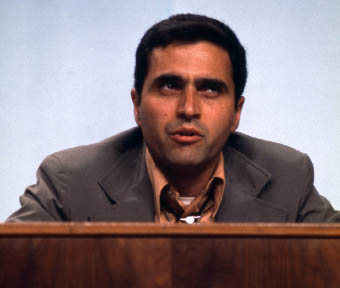
When the crew was officially named on August 13, 1971, NASA announced that geologist Schmitt, thirty-seven, would be the flight’s LMP, rather than former X-15 test pilot Joe Engle (who, with Cernan and Evans, had been on the backup crew for Apollo 14). (photo by Jacques Tiziou)
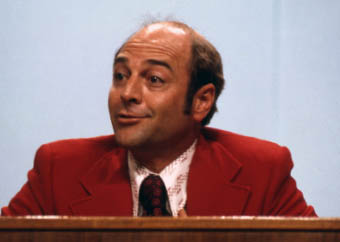
Evans, thirty-nine, was an F-8 fighter pilot during the Vietnam War aboard USS Ticonderoga —which would be Apollo 17’s recovery ship—when he was chosen as a NASA astronaut in 1966. Like Schmitt, Evans had his first and only space flight on Apollo 17. (photo by Jacques Tiziou)
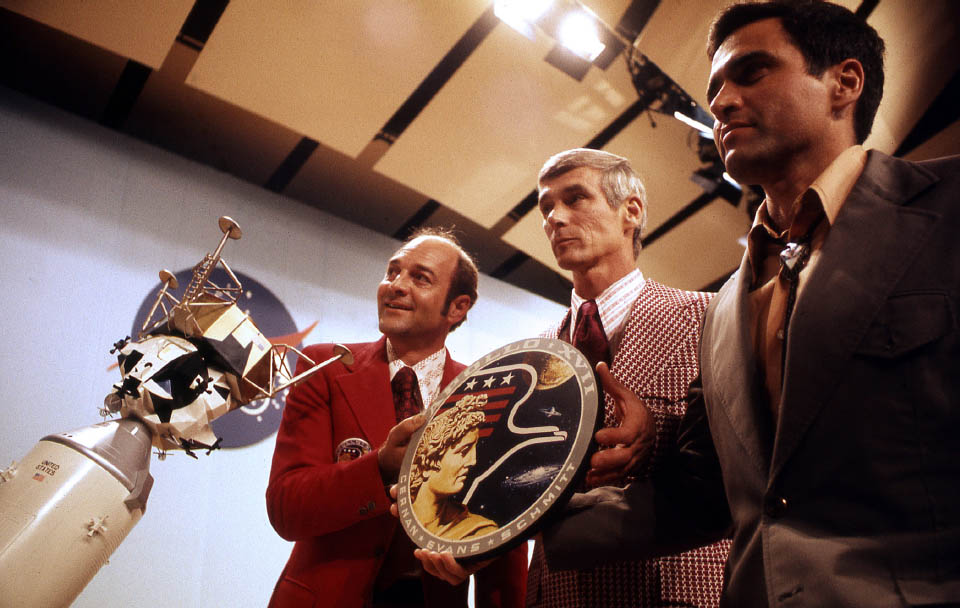
The Apollo 17 prime crewmen pose for photographs following their preflight news conference at MSC’s Bldg. 2 on November 10, 1972. Space artist Robert McCall designed the mission emblem. (photo by Jacques Tiziou)
The eighty-foot S-IVB of Apollo 17’s Saturn V is raised in the VAB’s high bay 1 on June 20, 1972, as workers watch from swing arm 6 on the LUT (top right ). The S-IVB would be mated with the Saturn’s S-II stage behind it, surrounded by work platforms.

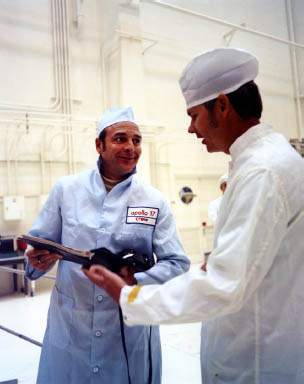
Evans (left ) visits the MSOB on August 15, 1972, to check on the CSM, which is being readied for a move to the VAB a week later. The Grumman logo is on the wall in the background.
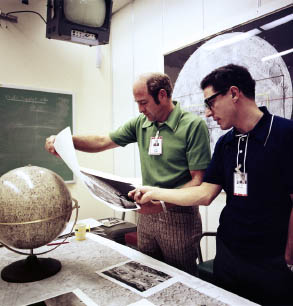
Evans (left ) studies lunar photographs and charts on October 11, 1972, in the MSOB crew quarters with Farouk El-Baz, an Egyptian American geologist. El-Baz was the supervisor of Lunar Science Planning for Bellcomm, an AT&T division that analyzed mission planning for NASA.
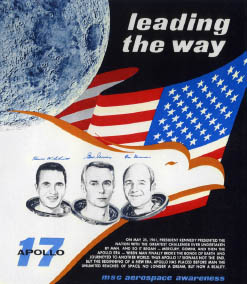
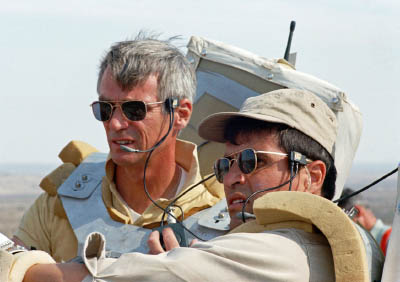
Cernan (left ) and Schmitt wear mock-up lunar backpacks during geology training near Sudbury, Ontario, Canada, on July 14, 1972. Apollo astronauts visited Sudbury, the site of the second-largest known impact crater on Earth, to study shatter cones—rare rock formations that only form in the bedrock beneath meteorite impact craters.
Schmitt, Cernan, and Evans climbed aboard the gray crawler-transporter behind them during the Saturn’s rollout to Pad 39A, to take photos with the crawler- transporter’s operators. After the launch vehicle reached the pad six hours later, the crewmen changed into pressure suits and posed with the LRV one-gee trainer for the photo on page 180 .
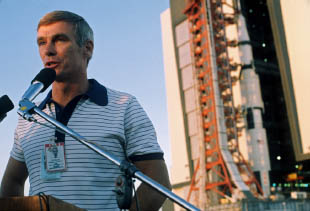
Shortly after 7:00 a.m. (EDT) on August 28, 1972, Cernan calls Apollo 17, the final manned lunar mission, “not the end but the beginning of a continuing quest for knowledge.” The flight’s Saturn V slowly emerges from the VAB.
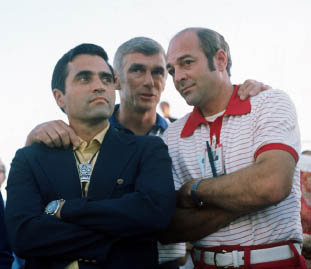
Schmitt, a New Mexico native, often wore bolo ties. He received his doctorate in geology from Harvard University and would later serve as a one-term US senator from his home state.
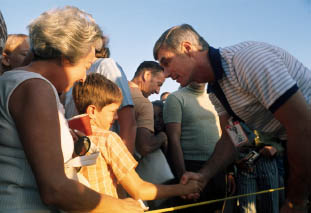
Cernan greets one of the nearly five thousand spectators who attended the rollout of the last Saturn V to carry astronauts.
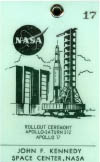
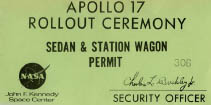
Sunrise at Pad 39A on launch morning, December 6, 1972. Many varieties of palm trees flourish in the 140,000-acre Merritt Island National Wildlife Refuge, an overlay of KSC established in 1963. The refuge is home to more than five hundred wildlife species, including Florida panthers, bald eagles, alligators, West Indian manatees, and wild boars. (photo by John de Bry)
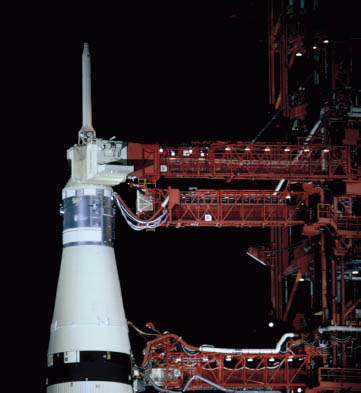
Early on launch day, a row of lights illuminates the top swing arm at the LUT’s 320-foot level, with the white room at left against Apollo 17’s CM. Aluminum paint covers the spacecraft’s SM. (photo by Steve Nolte)
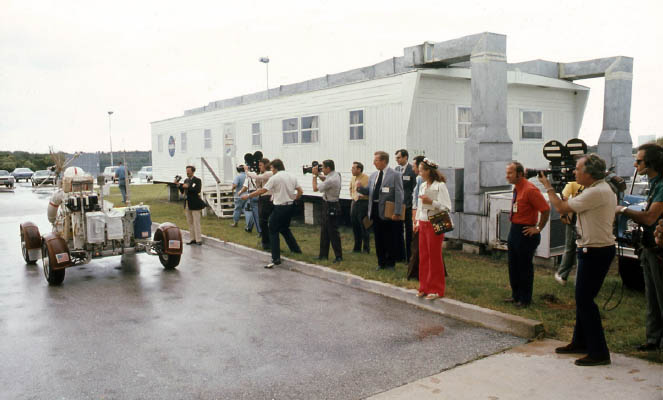
Cernan drives the LRV trainer on October 11, 1972, from the MSOB toward the outdoor simulated lunar training area known as the “rockpile.” Journalists include NBC’s Roy Neal (in the blue jacket) and Mary Bubb, of Fairchild Publications (right of Neal ). To her right, in the red shirt, is Ed Harrison, NASA public affairs officer. The Gemini suiting trailer, relocated from LC-16, is in the background. (photo by Jacques Tiziou)

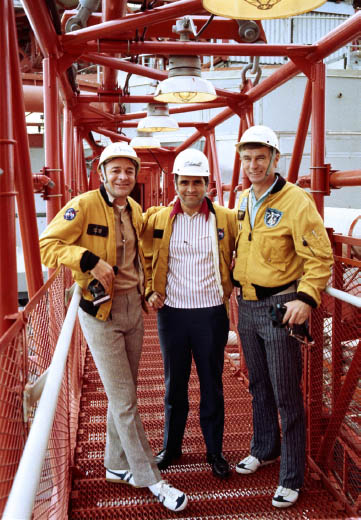
During a tour of Pad 39A on December 4, 1972, Evans, Schmitt, and Cernan pose on the swing arm that they will cross on launch day to board Apollo 17. All three carry respirators.
During the CDDT on November 21, NASA suit tech Al Rochford connects an oxygen hose to Cernan’s suit in the MSOB’s suiting room. Cernan rubs his nose on the helmet’s drinking port, which could also be used for consuming rehydrated food.
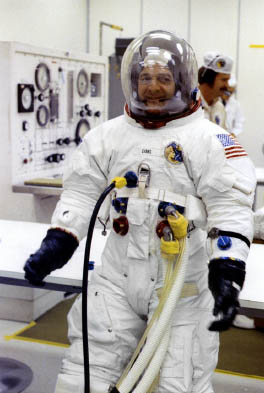
Evans during a suit leak and back pressure resistance check in the suiting room on the evening of December 6, with Rochford behind him. The black cable carried communications and biomedical data.
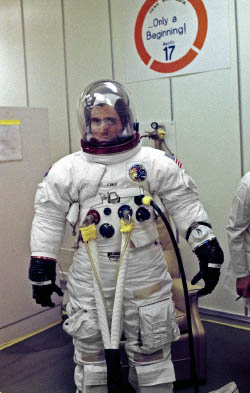
Schmitt on December 6. He wears an A7LB-model space suit, made by ILC. Oxygen entered the suit through the red inlet connector and left through the blue outlet connector. On his left wrist, Schmitt wears an Omega Speedmaster Professional watch, the only watch certified for space flight by NASA at the time.

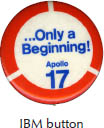
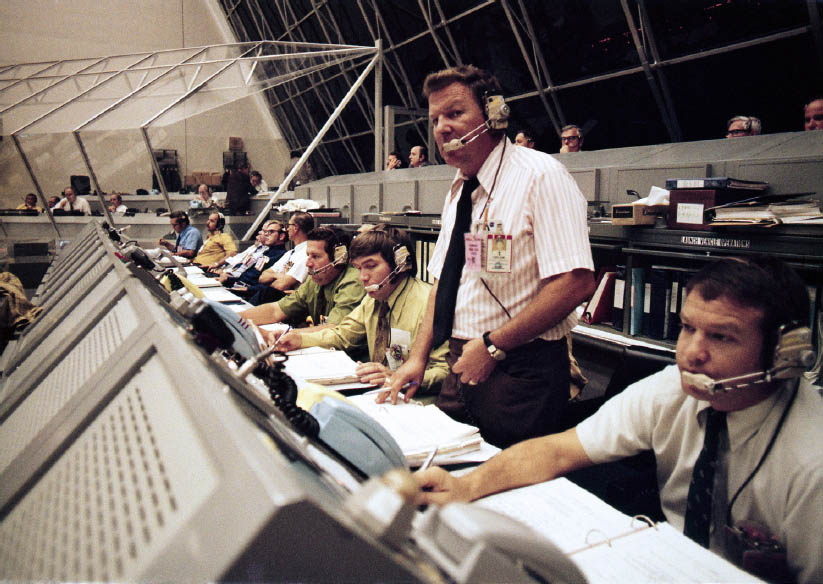
Norm Carlson, launch vehicle test conductor, stands at his console in Firing Room 1 during the CDDT on November 21, 1972. At right is test conductor Gary Powers; to Carlson’s right are John “Tip” Talone (next to Carlson ) and Bill Schick (in green), chief test supervisor. The glassed-in area at left was the operations management room. Carlson and Schick would continue as test managers into the Space Shuttle program, while Talone took on other KSC management roles.
Excess oxygen vapor vents from the Saturn’s stages on December 6, as the countdown enters an unplanned hold just thirty seconds before the booster’s expected launch. An automatic cutoff had been ordered by the launch sequencer, forcing a launch delay of one hour and forty minutes. (photo by John de Bry)

The reflective strip at right was used for increased visibility at the night launch’s security checkpoints.
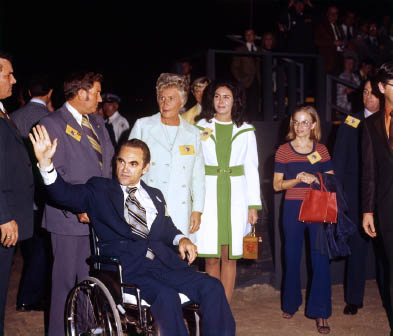
Governor George Wallace of Alabama was among those at the VIP viewing stand near the VAB. He had been left partially paralyzed during an assassination attempt less than seven months earlier. Gay Debus is second from left; Wallace’s wife, Cornelia, is in white. Other guests included Vice President Spiro Agnew; actors Connie Stevens, Eva Gabor, and Hugh O’Brian; singer Frank Sinatra; and comedian Jonathan Winters.
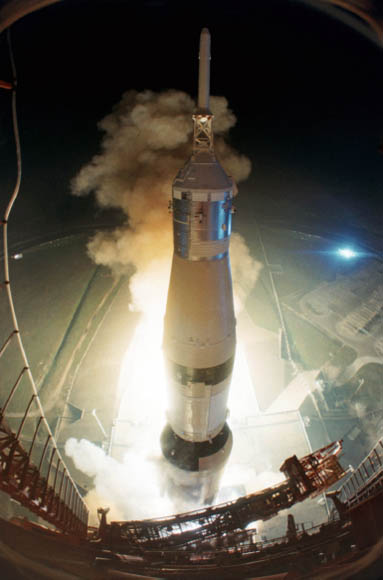
Apollo 17, seconds after main engine ignition. This photo was taken with a camera using a wide-angle fisheye lens, mounted near the 320-foot level of the LUT. One of the nine swing arms is at bottom.
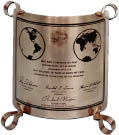
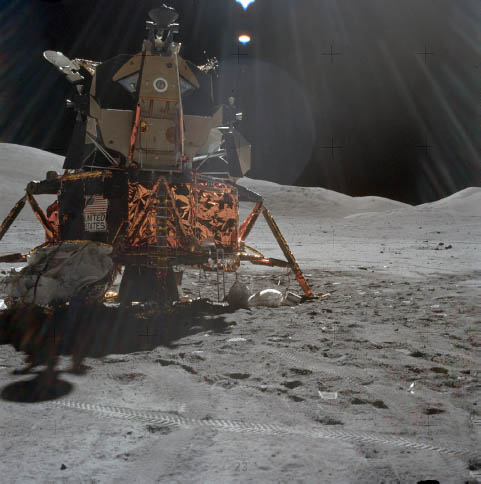
Much of Challenger ’s descent stage is covered with gold Mylar thermal blankets, which were hand-crinkled to minimize the heat transfer between layers. At left, a white blanket protects the MESA pallet, containing lunar surface tools, sample containers, and film and TV cameras. Rover tracks can be seen in this photo, taken on December 11.
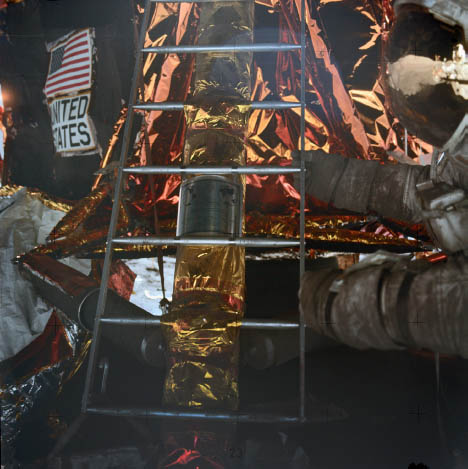
On December 13, Cernan, his gloves gray with lunar dust, holds the LM’s ladder after uncovering the mission’s stainless steel commemorative plaque (center ), mounted on the primary strut of the forward landing gear. Each LM carried such a plaque; Apollo 17’s was the only one to include a lunar disc showing all of the Apollo landing sites.
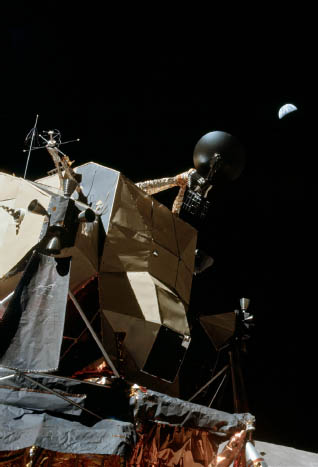
Cernan’s photo of Challenger looking south (during the third and final EVA, on December 13) shows Earth, which is to the right of the black radar antenna used to rendezvous with CM America . The sticklike EVA communications antenna is at top left, with a VHF communications antenna next to it. A conical S-band inflight communication antenna protrudes from the ascent stage at far left. Two of the LM’s four RCS quad thrusters are also visible at left and center.
In Schmitt’s photo, Cernan hammers a double core tube into the surface during EVA 3.
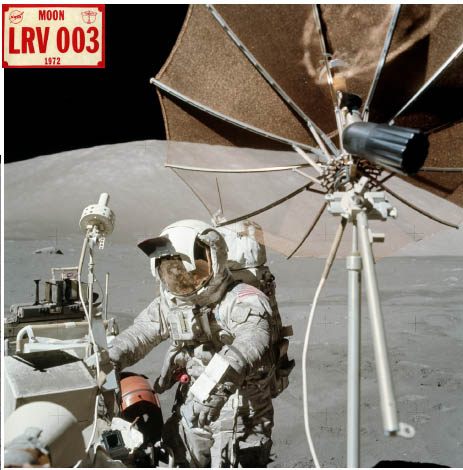
Schmitt works at the rover at the end of EVA 3, on December 13. The black object at upper right is the sighting scope for the rover’s high-gain antenna, used to communicate directly with Earth. The EVA crewmen had to realign it each time they moved the rover to a new location. At left is the low-gain antenna.
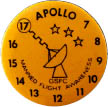
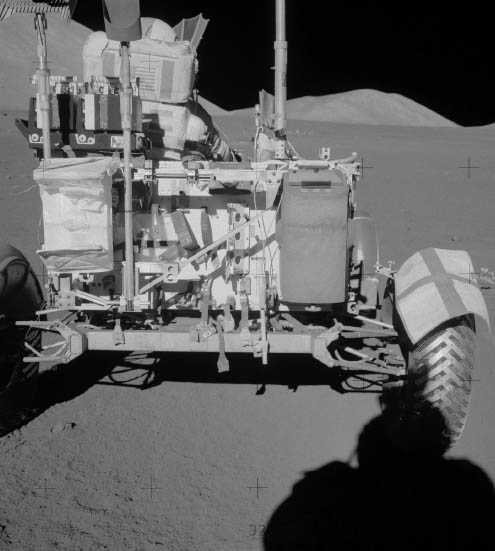
Schmitt’s photo, taken December 12, shows the astronauts’ makeshift repair to the LRV’s right-rear fender, which Cernan had accidentally broken off the previous day. They used duct tape to fasten together four lunar charts, and then attached them with two clamps borrowed from the LM to block lunar dust kicked up by the rover’s wheel.
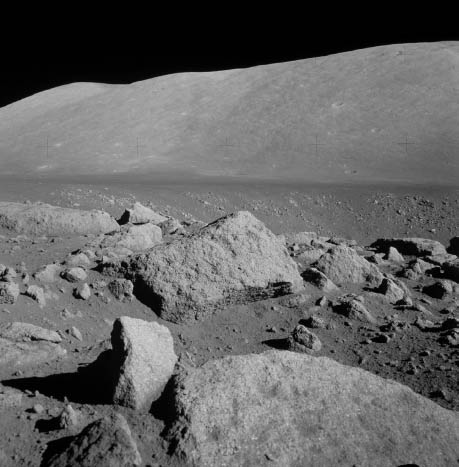
Photo taken by Cernan during EVA 2 on December 12, showing an elevated area known as the North Massif (background ) and the west wall of Camelot Crater (closer to the viewer, mid-frame ).
CM America (seen from Challenger ), seventy miles above the moon prior to docking on December 14. The SIM bay, with an extended spectrometer boom, is on the right side.
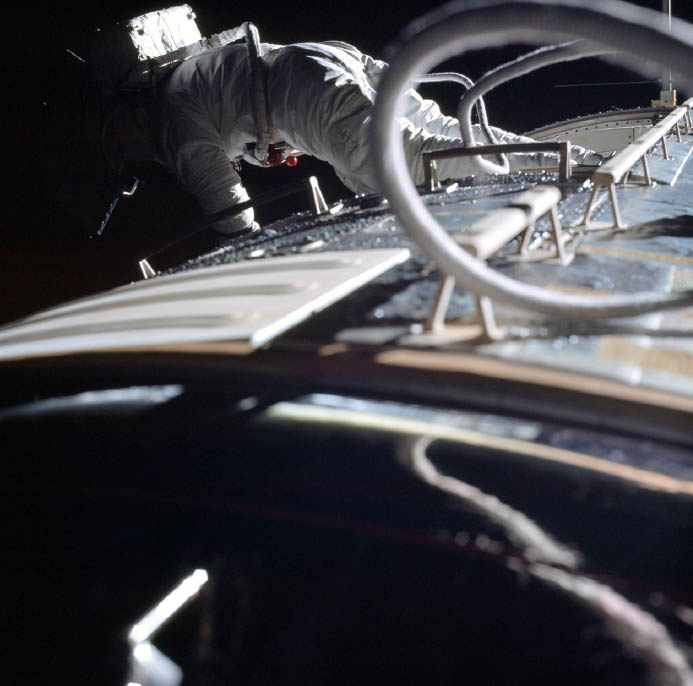
Evans retrieves film cassettes from the SIM bay on December 17, as Apollo 17 heads toward Earth. Extensive handrails on the SM worked well for his EVA.
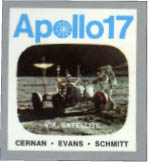
COMSAT (the Communications Satellite Corporation) provided ground stations that relayed Apollo TV from overseas antennas back to the United States.
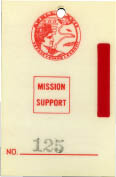
MSC badge
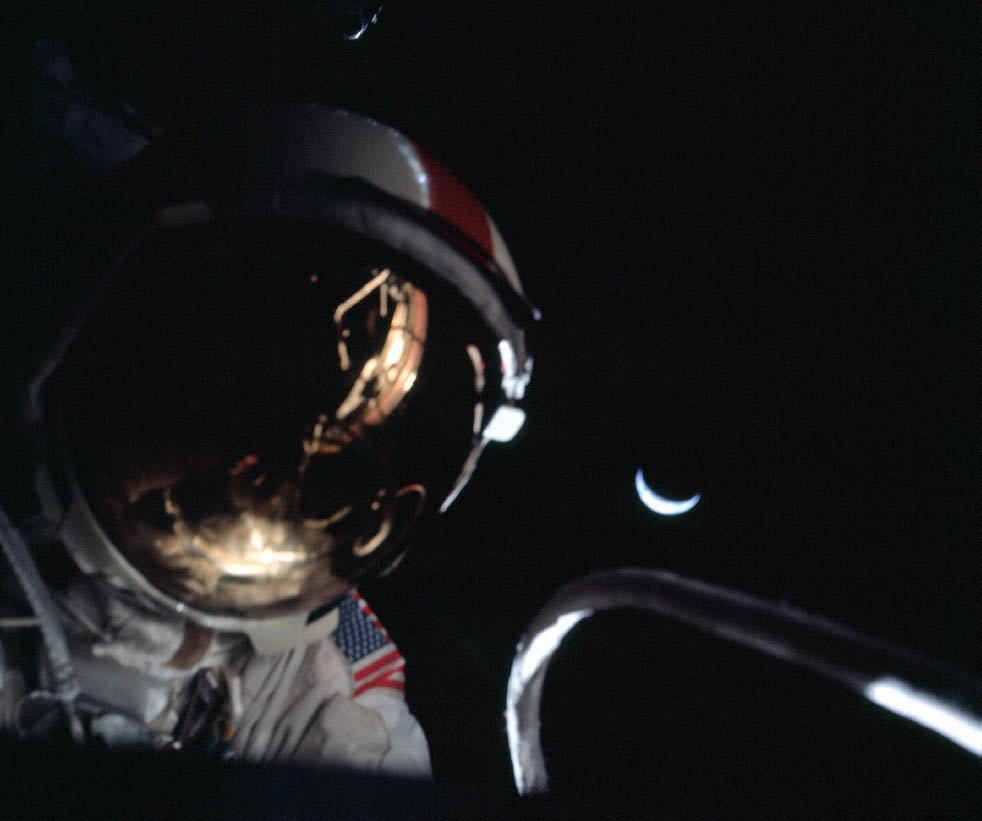
A crescent Earth is the backdrop in this photo of Evans and a loop of his tether, during his deep space EVA on December 17. He wears Cernan’s red-striped lunar EVA visor assembly. Evans spent just over an hour outside the spacecraft, which was still 184,000 miles from Earth.
Evans in front of America ’s optics panel, displaying a US flag and mission emblem on Beta cloth
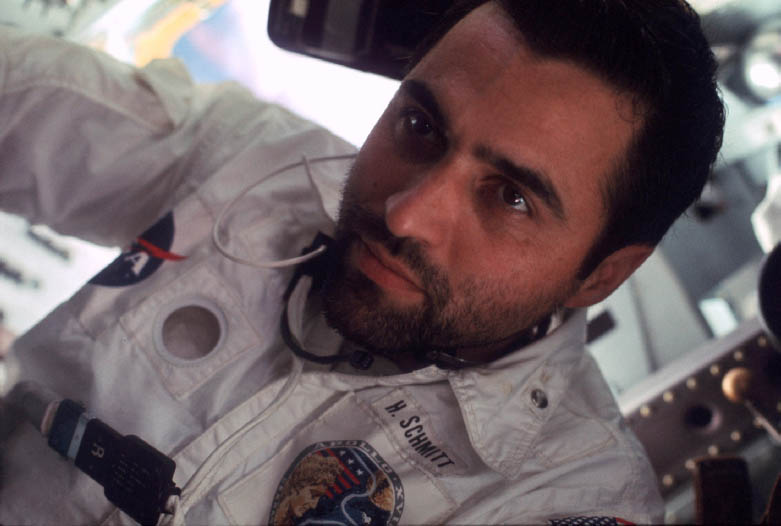
Schmitt during the trans-Earth (return) portion of the mission
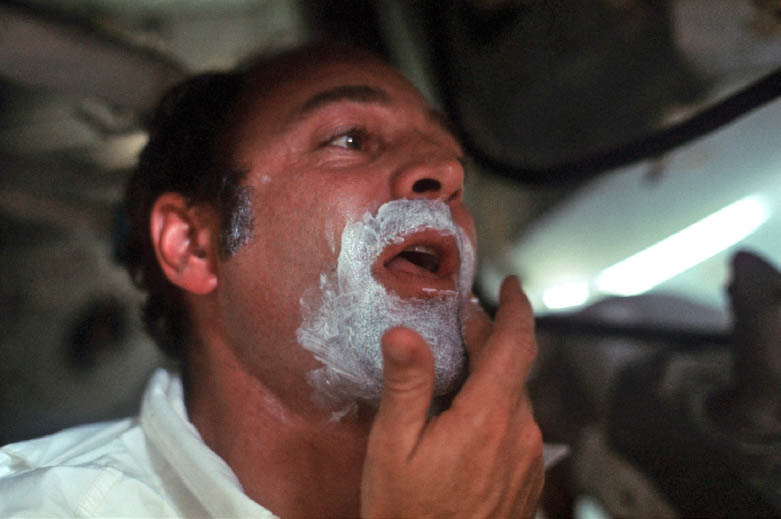
Evans applies brushless shaving cream from a tube. Apollo astronauts were issued Gillette Techmatic safety razors, but reported that they became easily clogged without the use of running water.

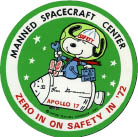
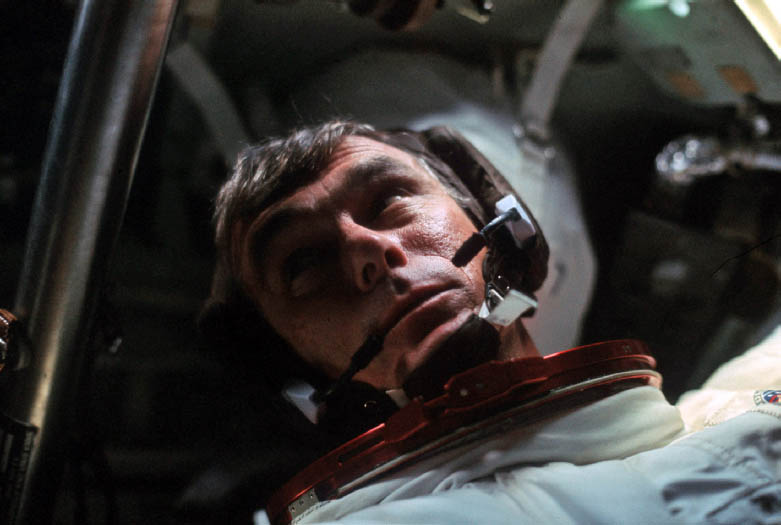
Cernan after returning to the CM from the LM
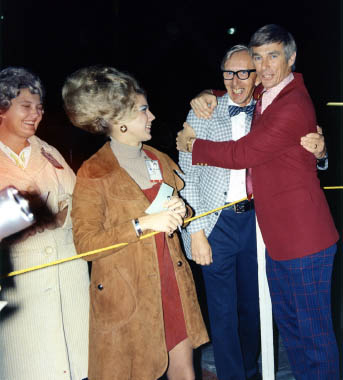
Cernan hugs NAR Pad Leader Guenter Wendt in the VAB’s transfer aisle during the February 20, 1973, KSC Reunion.
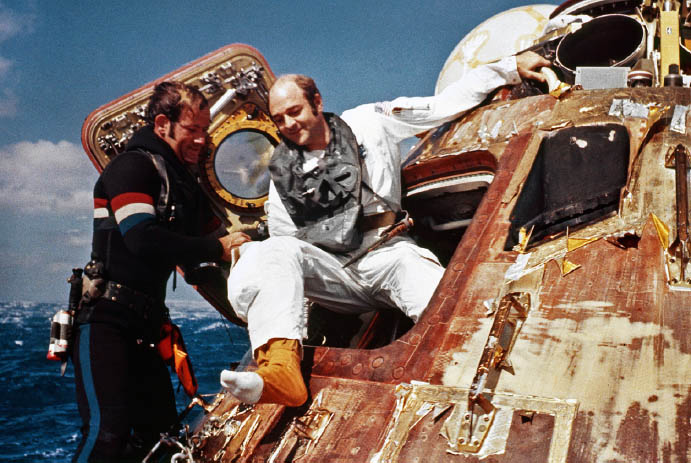
A diver with UDT-17 helps Evans egress from America . Foil covering the spacecraft had been mostly peeled away by the heat of atmospheric reentry. The large circular opening at top contained a drogue parachute mortar.
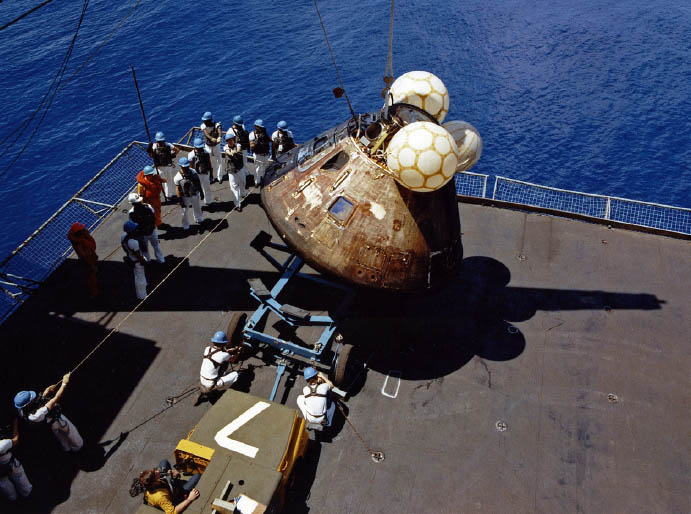
A crane lowers America onto a special carrier on the Ticonderoga ’s deck, two hours after splashdown. The spacecraft’s three uprighting flotation bags remain inflated.
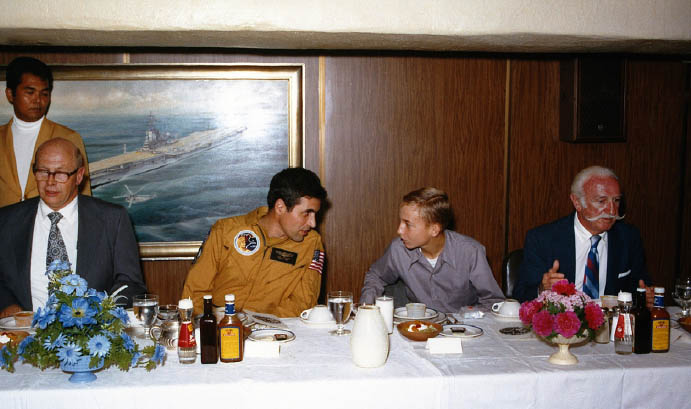
On December 19, Schmitt chats with twelve-year-old Kevin Steen during dinner in the Ticonderoga officers’ dining room. Steen, invited because he was believed to have terminal cancer, later went into remission. NASA’s Donald Stullken is left of Schmitt.
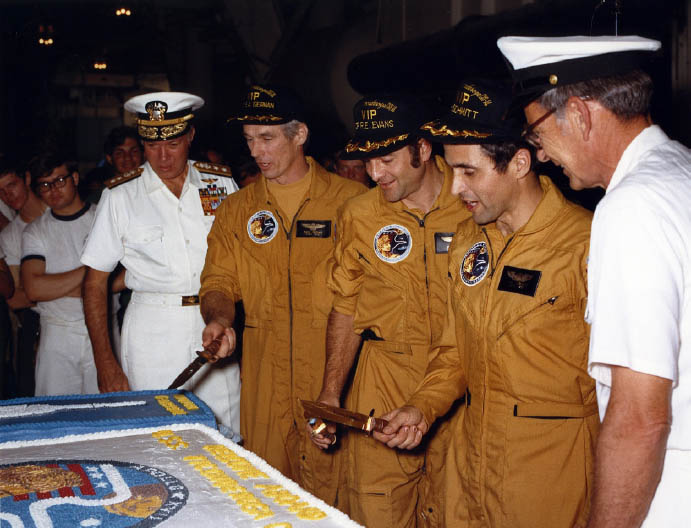
US Navy Rear Adm. John Butts (left )—commander of Task Force 130, the navy support unit for the splashdown—and Capt. Norman K. Green flank the Apollo 17 crewmen as they prepare to cut sheet cakes baked in their honor, using gold-plated survival knives.